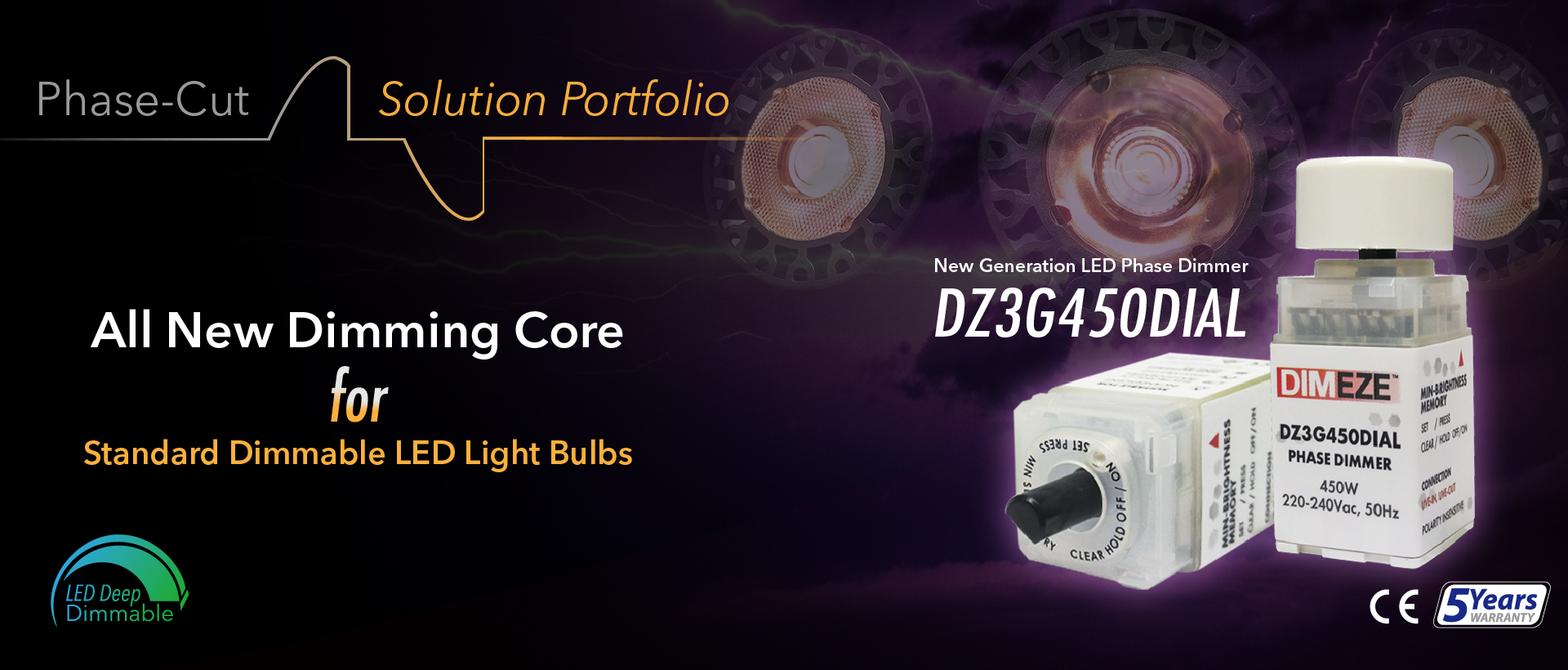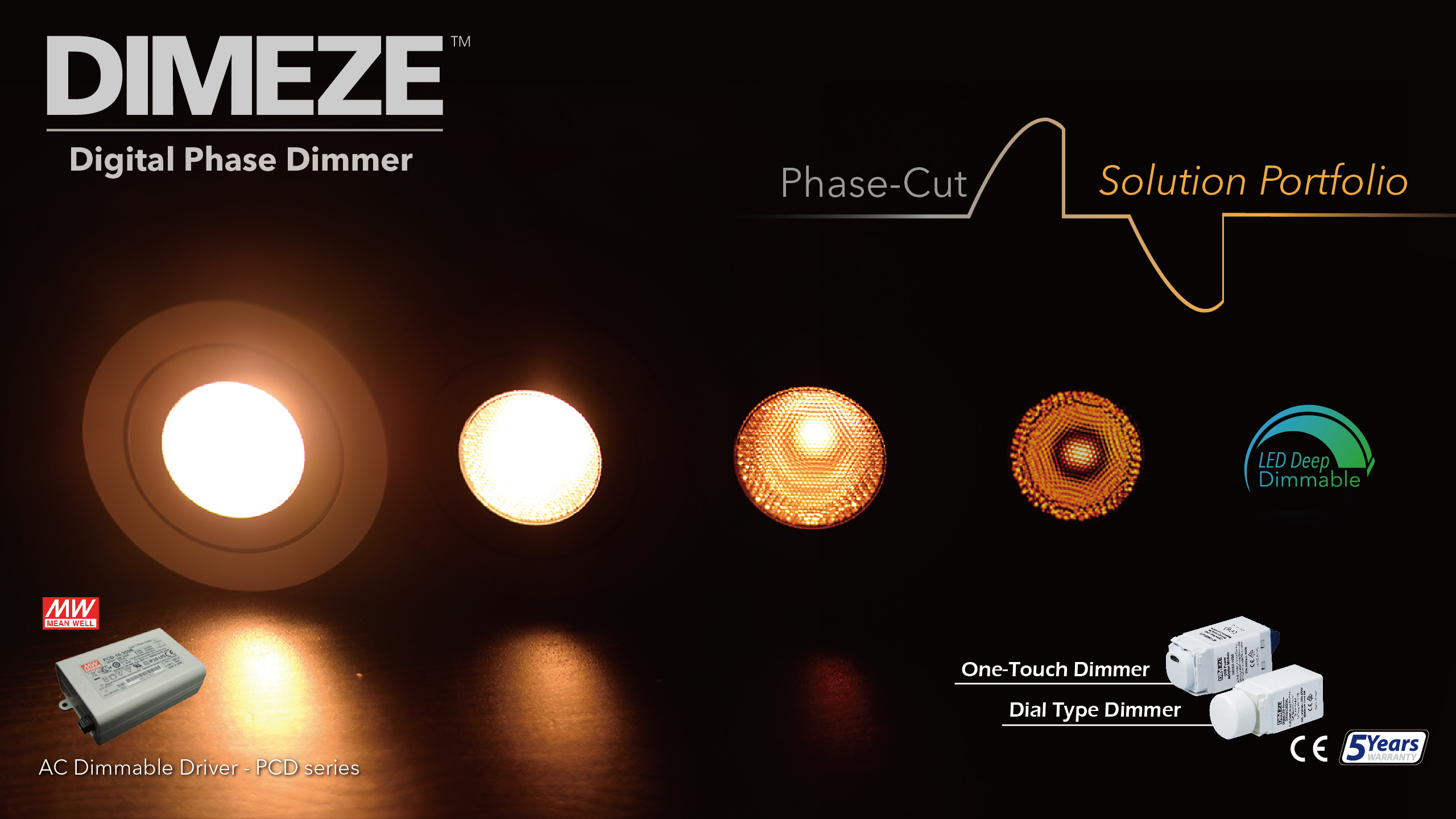Over time, we found it easiest to explain dimming by AC and DC control approaches. So, we shall discuss the relevant details with this
approach. Before the start, let's warm up with some basic concepts.
Dimmable Fixtures in a Non-Dimmable Circuit
Although people would find non-dimmable lamps somewhat reduce the brightness intensity as the input power reduces before the lights go off, clearly, this is not what we mean by dimming. Dimmable LED fixtures can smoothly manipulate the brightness intensity as users purposely dim the lights.
Let's consider the rated constant current of a dimmable LED driver as its maximum output current to the light; without a dimmer, the driver outputs at its max. So, we can use dimmable LED fixtures in a non-dimmable circuit, but the reverse is not valid.
LED Driver Classifications
When purchasing a new printer, we need to install the corresponding driver software for the specific model. Similarly, LED lights have different input requirements and thus, require specific LED drivers. If the driver's output voltage doesn't match, the LED lights won't function properly. Before we can select a driver for a LED light, as in the case of a LED recessed downlight, we shall have some understanding of LED drivers.
 Judging by the output, most LED drivers have constant current outputs, which are different from a standard laptop power supply. The LED driver usually has a rated constant current (mA) in a specific voltage range. For example, Meanwell APC-16-350 is a 16.8W non-dimmable LED driver with a constant current output of 350mA in the 12Vdc – 48Vdc range, whereas APC-16-700 is a 16.8W non-dimmable LED driver with a constant current output of 700mA in the 9Vdc - 24Vdc range.
Judging by the output, most LED drivers have constant current outputs, which are different from a standard laptop power supply. The LED driver usually has a rated constant current (mA) in a specific voltage range. For example, Meanwell APC-16-350 is a 16.8W non-dimmable LED driver with a constant current output of 350mA in the 12Vdc – 48Vdc range, whereas APC-16-700 is a 16.8W non-dimmable LED driver with a constant current output of 700mA in the 9Vdc - 24Vdc range.
While most LED drivers have constant current output, some have constant voltage output (12Vdc / 24Vdc / 48Vdc) that operate on PWM signal (right), and some have a constant power rating. More advanced LED drivers feature a dual-operation mode that can work as a constant current or a constant voltage driver depending on the loading condition. But in most cases, we shall be dealing with constant current LED drivers and focus on dimmable drivers that work on the Constant Current Reduction principle, meaning that the output current and the brightness intensity change along a dimming curve. See more on Dimmable LED Driver Selection.
In daily product selection, we’d be dealing with LED lights with integral drivers (e.g., a dimmable MR16 lamp) or external drivers. Since the LED driver dictates the dimming feature, we must specify a dimmable LED lamp or track light at the outset if it’s what we want. On the other hand, for LED downlights and light fixtures that usually have an external LED driver, we can replace a non-dimmable driver with a dimmable one. Other than that, prospects shall explore more about inrush current discussion and flicker-free options if these options are relevant to their applications.
AC (Phase-cut) Dimming
 As the name
implies, AC dimming is about manipulating the AC input power from the live wire
to dimmable LED fixtures. Since electrical systems operate in the form of AC
sinusoid waveform (110 / 220Vac), we can manipulate the input power by chopping
part of the sine wave. The more we chop, the subsequent lights receive less
input energy. Naturally, we can further identify two ways to chop the AC waveform:
Leading-edge (rising edge) and Trailing-edge (falling edge) phase-cut approach.
As the name
implies, AC dimming is about manipulating the AC input power from the live wire
to dimmable LED fixtures. Since electrical systems operate in the form of AC
sinusoid waveform (110 / 220Vac), we can manipulate the input power by chopping
part of the sine wave. The more we chop, the subsequent lights receive less
input energy. Naturally, we can further identify two ways to chop the AC waveform:
Leading-edge (rising edge) and Trailing-edge (falling edge) phase-cut approach.
Although the two
mutually exclusive methodologies work with incandescent and halogen lamps, the leading-edge approach has proven to cause different issues with LED lights or capacitive
loads. For LED dimming, it’s agreed to use the trailing-edge phase-cut dimming
methodology. Our Gen 2 phase dimmers feature a “Universal” control technology
that can automatically provide leading or trailing-edge phase-cut signal
subject to the load’s response. However, as trailing-edge is becoming more
popular with LED drivers and the trend to replace incandescent or halogen lamps
with LED lights is irreversible, we focus on trailing-edge output in our latter
dimming cores instead.
TRIAC Dimmer vs. Trailing-edge Dimmer
To set the stage for our discussion, let’s make a simple
classification of the key terms, such as phase-cut dimmers, TRIAC dimmers, and trailing-edge LED dimmers. Simply put, TRIAC dimmers are leading-edge dimmers.
Both TRIAC dimmers and trailing-edge LED dimmers are phase-cut dimmers that
manipulate the input power to the LED lights by chopping the sinusoid waveform
of the AC Mains.
TRIAC dimmers have been around since the incandescent and
halogen lights era. Given its long history, people often consider TRIAC dimmers
as the "light dimmer." The TRIAC dimmer replies on a single TRIAC IC (in the yellow box) and a few passive components to perform leading-edge phase control common in
small home appliances, such as hairdryers and toasters.
 If we open a TRIAC
dimmer, we'll immediately recognize the large heat sink attached to the TRIAC
IC. The large heatsink is responsible for the heat dissipation as the TRIAC IC
reduces the energy into the lights. From a product perspective, this large heat
sink posts a massive limitation in the size of the TRIAC Dimmer. Customer may
visualize the size difference of a TRIAC dimmer and our 450W trailing-edge LED
dimmer module!
If we open a TRIAC
dimmer, we'll immediately recognize the large heat sink attached to the TRIAC
IC. The large heatsink is responsible for the heat dissipation as the TRIAC IC
reduces the energy into the lights. From a product perspective, this large heat
sink posts a massive limitation in the size of the TRIAC Dimmer. Customer may
visualize the size difference of a TRIAC dimmer and our 450W trailing-edge LED
dimmer module!
Besides that, Electricians can judge whether a dimmer is
suitable for LED lighting by the dimmer's minimum load requirement; for
example, if a dimmer switch has a rated power of 50W – 400W (even 1000W), it is
likely designed for incandescent and halogen lights. Note a typical halogen
bulb is around 50W or 100W.
The issue with TRAIC dimmer with LED dimming is that LED
lights can operate at shallow current levels, leading to potential conflicts
with the TRIAC IC’s Holding Current, which is crucial for the semiconductor
device to sustain its operations. If the TRIAC IC can’t maintain its function,
flickering occurs. This parameter varies greatly across many component
suppliers, and the amount of current required to draw from the TRIAC IC is
subject to the fine production details. Hence, this crucial parameter
dependence introduces a critical potential fault for consistent dimming
performance and becomes a project nightmare.
Other than that, the severe inrush current and the
repetitive current spikes with TRIAC dimmers that weaken the product lifespan
are also valid causes for not using them with LED dimming. We met some
Electricians who would need to replace the TRIAC dimmers regularly. Trailing-edge dimmers have the advantage of avoiding repetitive current spikes
as found with leading-edge dimmers and processing other digital control
advantages. Thus, trailing-edge LED dimmers are preferred to the traditional
light dimmers and provide robustness in LED dimming.
DC Dimming
 On the other hand, DC dimming approach requires additional linkage (isolated low voltage) from a control unit to the dimmable fixtures, though the connection can be wired or wireless. The dimmable drivers adjust the brightness intensity upon receiving the control signal or command.
On the other hand, DC dimming approach requires additional linkage (isolated low voltage) from a control unit to the dimmable fixtures, though the connection can be wired or wireless. The dimmable drivers adjust the brightness intensity upon receiving the control signal or command.
The control signal can be analog, as in the case of 0/1-10V, or proprietary digital commands that consist of a device ID and instruction. The transmit and receive-ends often operate on a pre-defined communication protocol; hence, specific devices are required.
In the case of Smart Bulbs, the linkage between the control unit (i.e., mobile device control by application software) and the bulbs is a wireless connection. At the moment, Bluetooth (BLE), Wi-Fi, and a few others are the common wireless communication protocols. Since these fixtures / lamps embed a wireless module (the RF Tx / Rx block and command decode unit), fixture design has some limitations. In our Hybrid Dynamic Lighting control mode, we use a BLE or Wi-Fi module with 0-10V output to connect our DZ1G300TUNE controller to achieve wireless / intelligent control purposes.



 Judging by the output, most LED drivers have constant current outputs, which are different from a standard laptop power supply. The LED driver usually has a rated constant current (mA) in a specific voltage range. For example, Meanwell APC-16-350 is a 16.8W non-dimmable LED driver with a constant current output of 350mA in the 12Vdc – 48Vdc range, whereas APC-16-700 is a 16.8W non-dimmable LED driver with a constant current output of 700mA in the 9Vdc - 24Vdc range.
Judging by the output, most LED drivers have constant current outputs, which are different from a standard laptop power supply. The LED driver usually has a rated constant current (mA) in a specific voltage range. For example, Meanwell APC-16-350 is a 16.8W non-dimmable LED driver with a constant current output of 350mA in the 12Vdc – 48Vdc range, whereas APC-16-700 is a 16.8W non-dimmable LED driver with a constant current output of 700mA in the 9Vdc - 24Vdc range. As the name
implies,
As the name
implies,  If we open a TRIAC
dimmer, we'll immediately recognize the
If we open a TRIAC
dimmer, we'll immediately recognize the 